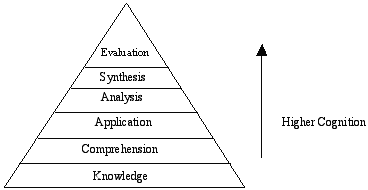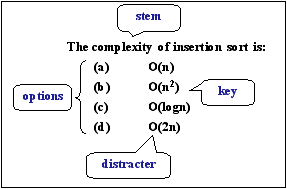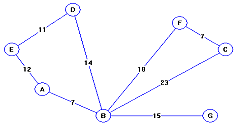
 |
| [ ASCILITE ]
[ 2004 Proceedings Contents ] |
As academics are confronted with problems such as larger classes and the introduction of a trimester year of study, it has become increasingly necessary to search for alternative forms of assessment. This is certainly the case in Information Technology (IT), where more lecturers are using multiple choice questions as a matter of expediency and in some instances, the quality of the assessment is being neglected. This paper provides guidance for IT lecturers who wish to write effective tests containing good multiple choice questions. Some of the points raised are founded in the long history of research into this form of assessment but IT lecturers are, in general, unlikely to be familiar with many of the matters discussed. The paper also considers the major criticism of multiple choice questions (that they do not test anything more than just straight recall of facts) and examines ways of overcoming this misconception. It is our aim to raise awareness of these issues in IT education, but teachers in other disciplines may also find the material useful.

Figure 1: Bloom's levels of cognition
In the paper we address the problem of how multiple choice questions can test more than just knowledge of a subject. Specifically we discuss the comprehension, application and analysis levels of cognition, and give examples of multiple choice questions to test students at these levels.
Firstly we review the terminology used to describe multiple choice questions and suggest methods for measuring their effectiveness, discussing a range of factors that should be considered when composing questions, such as:
The contribution of this paper is that it will provide guidance for IT teachers who want to set multiple choice questions while maintaining the integrity of their assessment.

Figure 2: The parts of a multiple choice question
A single multiple choice question, such as the one above, is known as an item. The stem is the text that states the question, in this case 'The complexity of insertion sort is'. The possible answers (correct answer plus incorrect answers) are called options. The correct answer (in this case b) is called the key, whilst the incorrect answers (a, c and d) are called distracters.
The code fragment 'char*p' is a way of declaring a
- pointer to a char.
- array of strings.
- pointer to a char or an array of strings.
A test wise student may identify option (b) as being incorrect as it starts with a vowel and the stem ends with 'a' and not 'an'. To avoid cueing a student in this manner, the options should include the article:
The code fragment 'char*p' is a way of declaring
- a pointer to a char.
- an array of strings.
- a pointer to a char or an array of strings.
There are several other grammatical considerations (Wilson & Coyle, 1991 ):
Three options
A well written multiple choice question with three options (one key and two distracters) can be at least as effective as a question with four options. According to Haladyna and Downing (1993) roughly two thirds of all multiple choice questions have just one or two effectively performing distracters. In their study they found that the percentage of questions with three effectively performing distracters ranged from 1.1% to 8.4%, and that in a 200 item test, where the questions had 5 options, there was not one question with four effectively performing distracters.
The argument for three options therefore is that the time taken to write third and possibly fourth distracter (to make a 4 or 5 option test) is not time well spent when those distracters will most likely be ineffective. In Sidick and Barrett (1994) it is suggested that if it takes 5 minutes to construct each distracter, removing the need for a third and fourth distracter will save ten minutes per question. Over 100 questions, this will save more than 16 hours of work. Supporters of 4 or 5 option tests would argue that any time saved would be negated by a decrease in test reliability and validity. Bruno and Dirkzwager (1995) find that, although reliability and validity are improved by increasing the number of alternatives per item, the improvement is only marginal for more than three alternatives.
Four or five option
The most significant argument against three option multiple choice tests is that the chance of guessing the correct answer is 33%, as compared to 25% for 4 option and 20% for 5 option exams. It is argued that if effective distracters can be written, the overall benefit of the lower chance of guessing outweighs the extra time to construct more options. However, if a distracter is non-functioning (if less than 5% of students choose it) then that distracter is probably so implausible that it appeals only to those making random guesses (Haladyna & Downing 1993).
Removing non-functioning options
Removing a non-functioning distracter (i.e. an infrequently selected one) can improve the effectiveness of the test. In Cizek and O'Day (1994) a study of 32 multiple choice questions on two different papers was undertaken. One paper had 5 option items, whilst the other paper contained 4 option items, a non-functioning item from the identical 5 option item having been removed. The study concluded that when a non-functioning option was removed, the result was a slight, non-significant increase in item difficulty, and that the test with 4 option items was just as reliable when compared to the 5 option item test.
Whilst the use of 'not' can be very effective, teachers should avoid the use of double negatives in their questions, as it makes the question and options much more difficult to interpret and understand.
A hybrid of the multiple answer and the conservative formats can be achieved, by listing the 'answers' then giving possible combinations of correct answers, as in the following example:
Which of the following statements initialises x to be a pointer?(i) int *x = NULL; (ii) int x[ ] = {1,2,3}; (iii) char *x = 'itb421';
- (i) only
- (i) and (ii) only
- (i), (ii) and (iii)
- (i) and (iii) only
In this format the student has to know the correct combination of answers. There is still a possibility that if they know one of the answers is incorrect then this may exclude one (or more) options, but by applying this hybrid format, a more thorough test of their knowledge is achieved.
The option 'all of the above' should be used very cautiously, if not completely avoided. Students who are able to identify two alternatives as correct without knowing that other options are correct will be able to deduce that 'all of the above' is the answer. In a 3 option test this will not unfairly advantage the student but in a 4 or 5 option test a student may be able to deduce that the answer is 'all of the above' without knowing that one or even two options are correct. Alternatively, students can eliminate 'all of the above' by observing that any one alternative is wrong (Hansen & Dexter, 1997). An additional argument against the use of 'all of the above' is that for it to be correct, there must be multiple correct answers which we have already argued against.
The use of 'none of the above' is more widely accepted as an effective option. It can make the question more difficult and less discriminating, and unlike 'all of the above', there is no way for a student to indirectly deduce the answer. For example, in a 4 option test, knowing that two answers are incorrect will not highlight 'none of the above' as the answer, as the student must be able to eliminate all answers to select 'none of the above' as the correct option.
In Knowles and Welch (1992) a study found that using 'none of the above' as an option does not result in items of lesser quality than those items that refrain from using it as an option.
 |
Given this undirected graph, what would be the result of a depth first iterative traversal starting at node E?
|
certain distracters would be ineffective - a distracter that did not include every node would be clearly wrong (option b). Most students would also realise that the second node in a traversal would usually be one close to the starting node, so writing an option that jumps suddenly to the other 'end' of the graph may also be easily discarded (option e).
When writing distracters for this question, a teacher should consider the types of mistakes associated with a poor understanding of the algorithm and attempt to offer distracters that include these errors. Additionally, an option containing the answer to a similar type of question could be a good distracter - for example, in this traversal question a distracter could contain the correct result for a depth first recursive traversal (option a) or a breadth first traversal (option d). Only a student who knows the correct algorithm and is able to apply it to the graph will be able to determine which of the plausible options (a, c or d) is the actual key.
A minimum heap functions almost identically to the maximum heap studied in class - the only difference being that a minimum heap requires that the item in each node is smaller than the items in its children. Given this information, what method(s) would need to be amended to change our implementation to a minimum heap?
- insert( ) and delete( )
- siftUp( ) and siftDown( )
- buildHeap
- none of the above
This question tests that the student understands the implementation of the maximum heap, and also asks them to translate some pre-existing knowledge into the new context of a minimum heap.
In Computer Science subjects there are many opportunities to test at the application level, for example asking the student to apply:
The question below tests application of knowledge by asking the student to apply a known algorithm.
 |
Consider the given AVL Tree. What kind of rotation would be needed to rebalance this tree if the value 'H' was inserted?
|
There are a several alternatives to this approach. For example, asking the student whether the code will have the desired effect may allow the writing of more plausible distracters, or alternatively, asking them to analyse some code and then make a comparison with some known code. For example:
Consider the code below which could be used to find the largest element into our sorted, singly linked list called SD2LinkedList. This code would fit one of the processing patterns that we studied in class. Which of the following methods fits the same pattern as this new code?
- union
- hasElement
- exclude
- isSubsetOf
This question not only tests the student's ability to analyse the new code, but also their knowledge of existing code and their ability to compare the way in which the given code processes data compared to that existing code.
Another method of testing a student's higher cognitive skills is through the use of linked sequential questions which allows the examiner to build on a concept. An example of this method would be to ask a number of questions each of which makes a small change to a piece of code, and to ask what effect that change would have on the functioning of a program. The student could be required to use the outcome of each question to answer the subsequent question. Using this technique, care needs to be taken to avoid unfairly penalising the student through accumulated or sequential errors.
Further, we have described how multiple choice questions can be used to test more than straight recall of facts. We gave specific examples which test students' comprehension of knowledge and their ability to apply and analyse that knowledge and we suggest that sequentially dependent questions also facilitate testing of higher cognition. Being able to set good questions which test higher cognition allows teachers to use multiple choice questions in end of semester summative tests with confidence, not just as a convenience for low valued mid-semester tests and formative assessment
In other related work, the authors are implementing a web based multiple choice management system. A stand alone prototype of this system (Rhodes, Bower & Bancroft 2004) is currently in use, while the web based system will allow further features, including concurrent access and automatic generation of paper based examinations.
Bruno, J.E. & Dirkzwager, A. (1995). Determining the optimal number of alternatives to a multiple-choice test item: An information theoretic. Educational & Psychological Measurement, 55(6), 959-966.
Carter, J., Ala-Mutka, K., Fuller, U., Dick, M., English, J., Fone, W. & Sheard, J. (2003). How shall we assess this? ACM SIGCSE Bulletin, Working group reports from ITiCSE on Innovation and technology in computer science education, 35(4), 107-123.
Cizek, G.J. & O'Day, D.M. (1994). Further investigation of nonfunctioning options in multiple-choice test items. Educational & Psychological Measurement, 54(4), 861-872.
Geiger, M.A. & Simons, K.A.(1994). Intertopical sequencing of multiple-choice questions: Effect on exam performance and testing time. Journal of Education for Business, 70(2), 87-90.
Haladyna, T.M. & Downing, S.M. (1993). How many options is enough for a multiple choice test item? Educational & Psychological Measurement, 53(4), 999-1010.
Hansen, J.D. & Dexter, L. (1997). Quality multiple-choice test questions: item-writing guidelines and an analysis of auditing testbanks. Journal of Education for Business, 73(2), 94-97.
Isaacs, G. (1994). HERDSA Green Guide No 16. Multiple Choice Testing. Campbelltown, Australia: HERDSA.
Knowles, S.L. & Welch, C.A. (1992). A meta-analytic review of item discrimination and difficulty in multiple-choice items using 'None of the Above'. Educational & Psychological Measurement, 52(3), 571-577.
Lister, R. (2001). Objectives and objective assessment in CS1. ACM SIGCSE Bulletin, ACM Special Interest Group on Computer Science Education, 33(1), 292-296.
Paxton, M. (2001). A linguistic perspective on multiple choice questioning. Assessment & Evaluation in Higher Education, 25(2), 109-119.
Rhodes, A., Bower, K. and Bancroft, P. (2004). Managing large class assessment. In R. Lister and A. Young (Eds), Proceedings of the sixth conference on Australian computing education. (pp.285-289). Darlinghurst, Australia: Australian Computer Society.
Sidick, J.T. & Barrett, GV. (1994). Three-alternative multiple choice tests: An attractive option. Personnel Psychology, 47(4), 829-835.
Wilson, T.L. & Coyle, L. (1991).Improving multiple-choice questioning: Preparing students for standardized tests. Clearing House, 64(6), 422-424.
| Authors: Peter Bancroft, School of Software Engineering and Data Communications, Queensland University of Technology, GPO Box 2434, Brisbane QLD 4001. p.bancroft@qut.edu.au Karyn Woodford, School of Software Engineering and Data Communications, Queensland University of Technology, GPO Box 2434, Brisbane QLD 4001. k.woodford@qut.edu.au Please cite as: Woodford, K. & Bancroft, P. (2004). Using multiple choice questions effectively in Information Technology education. In R. Atkinson, C. McBeath, D. Jonas-Dwyer & R. Phillips (Eds), Beyond the comfort zone: Proceedings of the 21st ASCILITE Conference (pp. 948-955). Perth, 5-8 December. http://www.ascilite.org.au/conferences/perth04/procs/woodford.html |
© 2004 Karyn Woodford & Peter Bancroft
The authors assign to ASCILITE and educational non-profit institutions a non-exclusive licence to use this document for personal use and in courses of instruction provided that the article is used in full and this copyright statement is reproduced. The authors also grant a non-exclusive licence to ASCILITE to publish this document on the ASCILITE web site (including any mirror or archival sites that may be developed) and in printed form within the ASCILITE 2004 Conference Proceedings. Any other usage is prohibited without the express permission of the authors.